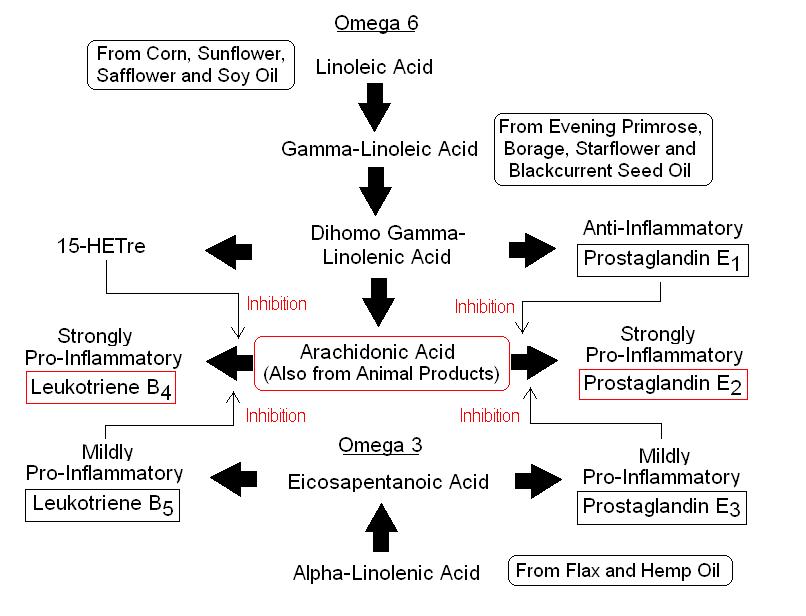Inflammation is a response by the body to infection or injury and is characterised by heat, pain, redness, swelling and loss of function. Inflammation occurs due an increase blood flow and an increased permeability of the capillaries which floods the local area primarily with white blood cells. This begins the process of removing invading pathogens or damaged tissue. Uncontrolled or inappropriate inflammation is increasingly being implicated in a number of diseases such as heart disease, arthritis, neurodegeneration, psoriasis and irritable bowel syndrome. Evidence is growing that dietary fats are a contributory factor in this inflammation, in particular an imbalance in the ratio of polyunsaturated fatty acids.
There are two polyunsaturated fatty acids found in our diets that are essential to health. These two fatty acids are alpha-linolenic acid and linoleic acid, which belong to the omega 3 and omega 6 categories of fatty acids respectively. Instead of using them for energy like most fats, the body converts the essential fatty acids to various metabolites which play vital roles in the modulation of inflammation. The key link between the essential fatty acids and inflammation are a number of short lived hormones called prostaglandins and leukotrienes (collectively called eicosanoids). These hormones are important because they regulate the production of a substance called arachidonic acid which is a key determinant of the response to inflammation. The body synthesises arachidonic acid from the omega 6 fatty acid linoleic acid (see figure 1).
 Figure 1. The metabolism of the essential fatty acids. 15-HETre = 15 Hydroxy-eicosatrienoic acid.
Figure 1. The metabolism of the essential fatty acids. 15-HETre = 15 Hydroxy-eicosatrienoic acid.
Arachidonic acid is converted into a number of pro-inflammatory mediators called series 2 prostaglandins (e.g. prostaglandin E2) and series 4 leukotrienes (e.g. leukotriene B4). These chemicals are responsible for triggering the inflammatory response. Arachidonic acid is converted to prostaglandin E2 and leukotriene B4 by two enzymes called cyclooxygenase and 5-lipoxygenase respectively. However, these two enzymes can be inhibited by metabolites of eicosapentanoic acid (EPA), which is synthesised in the body from alpha-linolenic acid and also found in fish oil. Eicosapentanoic acid can suppress production of the inflammatory mediators because it competes for the cyclooxygenase and 5-lipoxygenase enzymes. In this process it is converted to the much more benign 3 series prostaglandin (e.g. prostaglandin E3) or 5 series leukotrienes (e.g. leukotriene B5).
Diets that are high in the omega 6 fatty acids, but low in the omega 3 fatty acids will therefore favour the production of potent pro-inflammatory series 2 prostaglandins and series 4 leukotrienes leading to cellular inflammation. Increasing the dietary omega 3 fatty acids shifts the metabolism towards production of a less inflammatory series 3 prostaglandins and series 5 leukotrienes. In addition, arachidonic acid is present in animal products, and so eating a diet high in red meat can favour formation of pro-inflammatory compounds. In the typical western diet it has been estimated that the ratio of omega 6 to omega 3 is around 25 to 1, however a more suitable ratio might be closer to 3 to 1. The overabundance of the omega 6 fatty acids is due to the widespread use of sunflower, safflower, corn and soy oils which are all rich sources.
Fish oil is a good source of the omega 3 fatty acid EPA, and a growing number of studies are demonstrating an inhibitory effect on inflammation. Consuming fish oils allows EPA to build up in cells, and evidence shows that high tissue concentrations of EPA are more easily achieved with lower intakes of linoleic acid. In addition, the fatty acid gamma linoneic acid (GLA), an omega 6 fatty acid present in evening primrose oil, can also decrease tissue inflammation. GLA is converted to dihomo gamma-linonenic acid (DGLA) which is subsequently converted to the anti-inflammatory series 1 prostaglandins such as prostaglandin E1. The series 1 prostaglandins inhibit formation of series 2 prostaglandins by competing for the cyclooxygenase enzyme. DGLA can also form 15 hydroxy-eicosatrienoic acid, which is able to inhibit the formation of inflammatory series 4 leukotrienes by competing for 5-lipoxygenase.
Addressing imbalance in the ratio of omega 6 to omega 3 fatty acids in the diet is an essential step towards obtaining optimum nutrition. In addition, it would seem wise to limit animal products if consumption is excessive. Because the food sources of omega 3 fatty acids are limited, supplementation is usually the easiest way to incorporate a greater quantity into your diet. Fish oils are available, but care should be taken to find a product that is not contaminated with PCBs or dioxins. Eating oily fish can be an effective way to obtain omega 3 fatty acids, but farmed fish may contain pollutants and is therefore best avoided (here). Vegetarians who are unable to consume fish oils should look to consume a good quality cold pressed flax seed oil, or incorporate milled flax seeds and walnuts into the diet.
RdB
